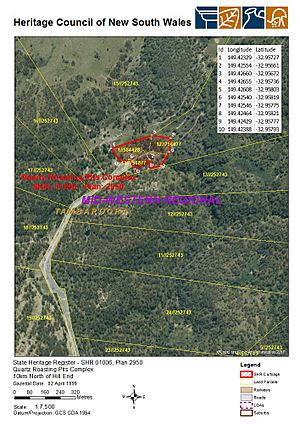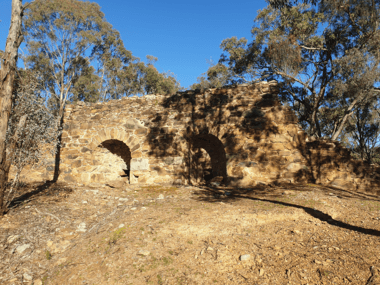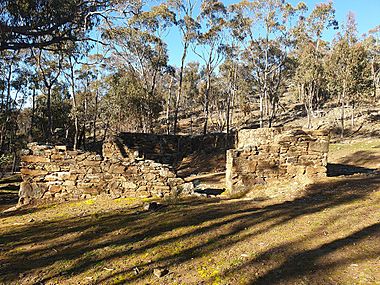Quartz Roasting Pits Complex facts for kids
Quick facts for kids Quartz Roasting Pits Complex |
|
|---|---|

Heritage boundaries
|
|
| Location | 10km north of Hill End, Mid-Western Regional Council, New South Wales, Australia |
| Built | 1854–1855 |
| Owner | Office of Environment and Heritage |
| Official name: Quartz Roasting Pits Complex; Cornish Roasting Pits | |
| Type | state heritage (archaeological-terrestrial) |
| Designated | 2 April 1999 |
| Reference no. | 1006 |
| Type | Quartz roasting kiln |
| Category | Mining and Mineral Processing |
| Lua error in Module:Location_map at line 420: attempt to index field 'wikibase' (a nil value). | |
The Quartz Roasting Pits Complex is a special historical site in New South Wales, Australia. It's about 10 kilometers north of a town called Hill End. This complex was built a long time ago, between 1854 and 1855. It's also known as the Cornish Roasting Pits. Today, the New South Wales Office of Environment and Heritage looks after this important place. It was officially added to the New South Wales State Heritage Register on April 2, 1999, because of its historical value.
History of the Gold Rush Site
The Hill End Quartz Roasting Pits Complex was built in 1855 by the Colonial Gold Mining Company. It was located on the traditional lands of the Wiradjuri people. The main goal was to help miners get gold from their claims in the Tambaroora and Hill End goldfields.
Early Gold Mining Methods
At that time, most gold was found by alluvial mining. This meant finding gold in riverbeds and shallow ground. However, the Tambaroora area also had some of Australia's first attempts at reef mining. This is where gold is found in hard rock veins, or "reefs," deep underground. This was happening over fifteen years before reef mining became very popular in the 1870s.
Why the Roasting Pits Were Built
The Quartz Roasting Pits Complex is one of Australia's oldest gold rush sites. It shows one of the first efforts to process gold from hard rock. It also represents a unique way to solve problems miners faced when trying to get gold from quartz reefs. This complex used one of the earliest methods of quartz firing (roasting) in Australia.
The complex had special kilns to roast gold-bearing quartz. It also had a clever system of batteries and dams to crush and wash the ore. Houses were built for the workers too. All these parts show us how technology, society, and daily life were connected during the early gold mining days in Australia.
Miners brought quartz rock with gold in it to the complex. The rock was roasted to make it softer and easier to crush. This roasting process was quite unusual. After roasting, a steam-powered machine called a battery crushed the rock into powder. Then, the gold was separated from the powder by sieving and washing.
Why the Complex Closed Down
Even though it was technologically advanced, the complex didn't last long. It was managed, and probably designed, by Alfred Spence. It closed in 1856, only 18 months after it opened. One reason might be that the early roasting methods weren't very good at getting all the gold out. Another reason could be that there wasn't enough gold in the nearby reefs. The company might not have checked the area thoroughly before building the complex.
What Happened After
After 1856, no major new buildings or changes happened at the site. The land was mostly used for grazing animals. In 1967, the National Parks and Wildlife Service took over ownership. Some archaeological digs were done by the University of Sydney in 1975. Parts of the battery and roasting pits were rebuilt in 1977.
Since 1997, efforts have been made to make the site stable. New signs have also been prepared to help visitors understand its history.
What the Complex Looks Like Today
The Roasting Pits Complex is about 10 kilometers north of Hill End. It's also about 2.5 kilometers north of Valentine's Mine, which was a main source of gold-rich quartz. The site sits in a small, gently sloping valley with a shallow stream running through it.
Main Structures
The complex includes:
- A pair of kilns (large ovens) for roasting quartz.
- A battery building that held machines for crushing ore.
- A dam to supply water.
- The remains of two houses where the manager and workers lived.
The Battery and Roasting Pits are the most noticeable parts of the site, just as they would have been in the 1850s. Most other structures are hidden by plants today. However, when the complex was active, the area would have been bare. You would have had a clear view of mining activities on the surrounding hills. Even now, you can still see signs of this harsh, industrial landscape if you look closely.
Because the complex was only open for a short time, most of the main buildings were likely built around 1855. When it closed, some equipment was probably taken or reused. Apart from grazing and farming, the site hasn't been used much since then.
The Roasting Pits
The Roasting Pits are a two-chamber kiln structure. They are located on the hill, uphill from the Battery. The pits are made of strong stone, mostly shale and greywacke. Each kiln has a cone-shaped pit that opens at the top. It narrows sharply towards the ground level at the front. Each pit is built in front of an artificial mound that connects to the hillside.
The Battery Building
The Battery sits on the valley floor, about 20 meters below the Roasting Pits. This is where the ore was crushed after it was roasted. The Battery was placed near Fighting Ground Creek. This allowed waste material (tailings) to run off and provided easy access to water from the Dam upstream. Placing it directly below the Roasting Pits also made it easier to move the roasted ore from one step to the next.
The Battery is a large building with two main areas. It has a solid stone platform with spaces for machinery. It faces roughly north-south, parallel to the creek bank. The western side of the building is cut into the slope, while the eastern side is built on the flat creek terrace.
Other Features
Other historical features are spread throughout the surrounding bush. These include the remains of houses and a large earth dam to the north-east of the battery. Experts believe the site has high archaeological potential, meaning it could reveal a lot more information through further study. The ruins are still in good condition, showing their original design.
Why This Site is Important
The Hill End Quartz Roasting Pits are very important to Australia's history. It is one of the earliest gold mining sites that is still mostly intact.
Rare Technology
The site shows how an unusual technology was used in Australia. This technology helped deal with the very hard quartz rock that contained gold. As an industrial site, you can still see all the different parts of the gold extraction process and the buildings that supported it.
Understanding Early Gold Mining
This site helps us understand how money was invested, how technology from other countries was brought to Australia, and how mining worked at the very beginning of the gold boom. The gold rush was a huge event that changed Australia forever.
The Roasting Pits are important because they are a rare example of a common design for making lime being used for roasting quartz. They show how things were done before more specialized quartz roasting kilns were developed.
Oldest Battery Building
The Battery building is also very important. It was built specifically to hold a boiler, a beam engine, and a stamper battery (the crushing machine). It is the oldest surviving stamper battery building built for gold mining in Australia. It is still mostly intact and helps us understand how it worked.
Supporting Structures
Other parts of the complex, like the Dam and the workers' houses, are also important. They help us understand all the different parts needed to operate the Roasting Pits.
The fences from when the site was used in 1871 are also important to the region.
The Quartz Roasting Pits Complex was added to the New South Wales State Heritage Register on April 2, 1999, because it met several important criteria.
Historical Importance
The Hill End Quartz Roasting Pits are historically important because they show the first stage of the gold rushes. These rushes completely changed Australia's economy in the 1800s. The site represents money invested and technology brought from overseas. It shows how early gold rushes worked and how unusual some of the methods were. It's a powerful reminder of early reef mining, which didn't become a big deal in Hill End until the 1870s. By studying the site, we can learn about how technology was transferred and experimented with during the early gold rush period.
Design and Achievement
The area around the Roasting Pits is beautiful, with a mix of farms, cleared land, and forests. The look of the Battery, the Roasting Pits, and other features makes you think about the exciting history of gold mining. It shows how the peaceful natural setting contrasts with the busy, noisy industrial work that happened there.
The Roasting Pits and the Battery were carefully designed. It's clear they were built using prepared plans and were meant to work together as one unit. The design of the Roasting Pits shows how a common design for lime kilns was used for roasting quartz with only small changes. This design was well-known, but it's rare to see it used for quartz. This type of design was replaced by more advanced ones within ten years.
The Battery was one of the first buildings of its kind in Australia built to house a stamper battery. It was a mix of architectural design and engineering to create the best structure for its purpose. As stampers became more common, they were often put in simpler buildings, not as carefully built as this one.
Community Connection
The Quartz Roasting Pits Complex represents an early part of Hill End and Tambaroora's connection to gold. Since 1967, the National Parks and Wildlife Service has managed Hill End as an example of 1800s gold mining towns and landscapes. This has made the site important to the local community today. The history of the area is still a big part of daily life.
Learning from the Site
The technology used at the Quartz Roasting Pits is rare, making it very important for research. Roasting was not common in Australia. It shows the first ten years of gold mining in Australia, when people didn't know much about the materials and didn't have the right equipment. The site is still mostly complete, which makes it even more interesting for understanding technology. The main parts of the industrial complex are still there and can be understood in relation to each other.
The site also shows how technology was transferred. This includes people, like the Cornish miners bringing their mining knowledge and designs to Australia. It also includes machines, like English money, English and colonial kiln designs, and American stampers and gold extraction technology.
There are still things we don't know about the complex's layout, its history as a company, how it worked, and how successful it was. Archaeology can help us find these answers.
This type of site, from the first phase of gold mining, is very rare and still intact. Many early gold rush sites have been destroyed by later mining or new techniques. Sites from this period are naturally rare because they are easily damaged.
Through archaeological study, the Quartz Roasting Pits complex can teach us more about itself. It can also teach us about how technology was transferred and adapted during the early gold mining period in Australia.
Because it is largely intact, the site can help us understand the relationships between different levels of people in the mining industry. It can also show how human and technological systems worked together. We could investigate the money invested to create the complex and how this affected the daily lives of those who worked there. This can be compared to the lives of those who worked for themselves on the goldfields.
Rarity of the Site
The Quartz Roasting Pits Complex is extremely rare in its technical, research, and historical importance.



